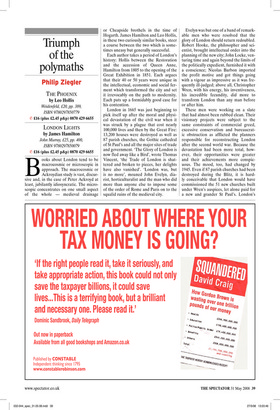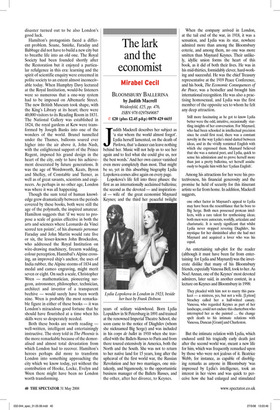Triumph of the polymaths
Philip Ziegler
THE PHOENIX by Leo Hollis Weidenfeld, £20, pp. 389, ISBN 9780297850779 ✆ £16 (plus £2.45 p&p) 0870 429 6655 LONDON LIGHTS by James Hamilton John Murray, £25, pp. 400, ISBN 9780297850079 ✆ £16 (plus £2.45 p&p) 0870 429 6655 Books about London tend to be macrocosmic or microscopic in approach. The macrocosmic or Ackroydian study is vast, discursive and, in the case of Peter Ackroyd at least, jubilantly idiosyncratic. The microscopic concentrates on one small aspect of the whole — medieval drainage or Cheapside brothels in the time of Hogarth. James Hamilton and Leo Hollis, in these two curiously similar books, steer a course between the two which is sometimes uneasy but generally successful.
Each author takes a period of London’s history: Hollis between the Restoration and the accession of Queen Anne, Hamilton from 1805 to the opening of the Great Exhibition in 1851. Each argues that their 40 or 50 years were unique in the intellectual, economic and social ferment which transformed the city and set it irrevocably on the path to modernity. Each puts up a formidably good case for his contention.
London in 1665 was just beginning to pick itself up after the moral and physical devastation of the civil war when it was struck by a plague that cost nearly 100,000 lives and then by the Great Fire: 13,200 houses were destroyed as well as 87 parish churches, the Gothic cathedral of St Paul’s and all the major sites of trade and government. ‘The Glory of London is now fled away like a Bird’, wrote Thomas Vincent, ‘the Trade of London is shattered and broken to pieces, her delights have also vanished’. ‘London was, but is no more’, moaned John Evelyn, diarist, horticulturalist and the man who did more than anyone else to impose some of the order of Rome and Paris on to the squalid ruins of the medieval city. Evelyn was but one of a band of remarkable men who were resolved that the glory of London should return redoubled. Robert Hooke, the philosopher and scientist, brought intellectual order into the planning of the new city; John Locke, venturing time and again beyond the limits of the politically expedient, furnished it with a conscience; Nicolas Barbon imported the profit motive and got things going with a vigour as impressive as it was frequently ill-judged; above all, Christopher Wren, with his energy, his inventiveness, his incredible fecundity, did more to transform London than any man before or after him.
These men were working on a slate that had almost been rubbed clean. Their visionary projects were subject to the same constraints of commercial greed, excessive conservatism and bureaucratic obstruction as afflicted the planners responsible for reconstructing London after the second world war. Because the devastation had been more total, however, their opportunities were greater and their achievements more conspicuous. The mood, too, had changed by 1945. Even if 87 parish churches had been destroyed during the Blitz, it is hardly conceivable that London would have commissioned the 51 new churches built under Wren’s auspices, let alone paid for a new and grander St Paul’s. London’s disaster turned out to be also London’s good luck.
Hamilton’s protagonists faced a different problem. Soane, Smirke, Faraday and Babbage did not have to build a new city but to breathe life into an old one. The Royal Society had been founded shortly after the Restoration but it enjoyed a particular refulgence in this era: learning and the spirit of scientific enquiry were esteemed in polite society to an extent almost inconceivable today. When Humphry Davy lectured at the Royal Institution, would-be listeners were so numerous that a one-way system had to be imposed on Albemarle Street. The new British Museum took shape, with the King’s Library at its heart; there were 40,000 visitors to its Reading Room in 1831. The National Gallery was established in 1824, the royal gardens at Kew were transformed by Joseph Banks into one of the wonders of the world. Brunel tunnelled under the Thames, balloons soared ever higher into the air above it, John Nash, with the enlightened support of the Prince Regent, imposed his grand design in the heart of the city, only to have his achievement desecrated by future generations. It was the age of Wordsworth, Keats, Byron and Shelley, of Constable and Turner, as well as of great savants, scientists and engineers. As perhaps in no other age, London was where it was all happening.
Though the sum total of human knowledge grew dramatically between the periods covered by these books, both were still the age of the polymath, the inspired amateur. Hamilton suggests that ‘if we were to propose a scale of genius effective in both the arts and sciences where Leonardo da Vinci scored ten points’, of his dramatis personae Faraday and John Martin would rate five or six, the lesser-known John Brockedon, who addressed the Royal Institution on wire-drawing machinery, firearm wadding, colour perception, Hannibal’s Alpine crossing, an improved ship’s anchor, the uses of India rubber, the Alpine storms of 1834 and medal and cameo engraving, might merit seven or eight. On such a scale, Christopher Wren — mathematician, pioneering surgeon, astronomer, philosopher, technician, architect and inventor of a transparent beehive — would surely have been worth nine. Wren is probably the most remarkable figure in either of these books — it was London’s miraculous good fortune that he should have flourished at a time when his skills were so desperately needed.
Both these books are worth reading — well-written, intelligent and entertainingly instructive. The story told in The Phoenix is the more remarkable because of the demoralised and almost total devastation from which London had to recover. Hamilton’s heroes perhaps did more to transform London into something approaching the city which we know today, yet without the contribution of Hooke, Locke, Evelyn and Wren there might have been no London worth transforming.











































































 Previous page
Previous page